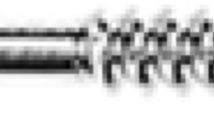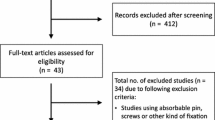Abstract
Introduction
Multiple operative techniques are currently used for finger arthrodesis in clinical practice. The present study was designed to compare the biomechanical characteristics of typical arthrodesis techniques used in daily practice.
Material and methods
Osteosynthesis techniques comprising wire cerclage, thread cerclage (PDS) or intraosseous wire suture were compared in a biomechanical experiment for resistance against bending loads. The mentioned techniques were applied to artificial specimens with resected articular surfaces or by using the cup-and-cone procedure. In this process, the specimens were tested using various Kirschner-wire insertion angles as well as different arthrodesis angles (20° vs 40°) in a 4-point bending test with each group consisting of 6 specimens of acrylic glass. The forces prevalent in the joint space were determined by prescale pressure measurement foils.
Results
Wire tension banding resisted significantly higher bending moments than arthrodeses with thread tension bands (p<0.05). All set-ups with tension banding techniques tolerated significantly higher loads than the intraosseous wire sutures without additional K-wires (p<0.05), which showed unfavorable dislocation of contact areas resulting in instability even under relatively minor bending loads. Using the cup-and-cone technique, a geometrically larger contact area could be achieved between two unloaded fragments, but this technique showed no advantages in the opposing bending moments compared with the conventional resection method. In both techniques, a dislocation of contact surfaces towards the palmar direction could be observed with increasing bending moment. While the use of thread tension band fixation reduces the risk of plastic deformation of both osteosynthetic material and bone stock, the problem of resorption rate has to be taken into account when choosing the material for the thread.
Conclusions
Considering pressure distribution and stability with and without bending loads, it is not the most rigid osteosynthesis technique which should be viewed as the ideal treatment. In contrast, it is more important to consider the various and most likely conditions to be expected in daily life after arthrodesis and therefore to chose the type of technique distributing pressure as regularly as possible.






Similar content being viewed by others
References
Ayres JR, Goldstrohm GL, Miller GJ, Dell PC (1988) Proximal interphalangeal joint arthrodesis with the Herbert screw. J Hand Surg Am 13:600–603
Bishop AT (1993) Small joint arthrodesis. Hand Clin 9:683–689
Braun C, Mittelmeier W, Gross G, Bühren V (1992) Die Zuggurtungsarthrodese von Fingergelenken. Chir Praxis 45:245–252
Braun RM, Rhoades CE (1985) Dynamic compression for small bone arthrodesis. J Hand Surg Am 10:340–343
Buck-Gramcko D, Oehme S (1988) Fingergelenkarthrodesen mit intraossärer Drahtnaht und Kirschnerdraht. Handchir Mikrochir Plast Chir 20:99–106
Burton RI, Margles SW, Lunseth PA (1986) Small-joint arthrodesis in the hand. J Hand Surg Am 11:678–682
Carroll RE, Hill NA (1969) Small joint arthrodesis in hand reconstruction. J Bone Joint Surg Am 51:1219–1221
Früh HJ (1996) Faserverstärkte Kunststoffe für die Kniegelenksendoprothetik. Hieronymus, Munich
Heller MO, Bergmann G, Deuretzbacher G, Durselen L, Pohl M, Claes L, Haas NP, Duda GN (2001) Musculo-skeletal loading conditions at the hip during walking and stair climbing. J Biomech 34:883–893
Jones BF, Stern PJ (1994) Interphalangeal joint arthrodesis. Hand Clin 10:267–275
Knoop M, Lünstedt B, Thiede A (1987) Maxon und PDS—Bewertung physikalischer und biologischer Eigenschaften monofiler, absorbierbarer Nahtmaterialien. Langenbecks Arch Chir 371:13–28
Kovach JC, Werner FW, Palmer AK, Greenkey S, Murphy DJ (1986) Biomechanical analysis of internal fixation techniques for proximal interphalangeal joint arthrodesis. J Hand Surg Am 11:562–566
Leibovic SJ, Strickland JW (1994) Arthrodesis of the proximal interphalangeal joint of the finger: comparison of the use of the Herbert screw with other fixation methods. J Hand Surg Am 19:181–188
Leonard MH, Capen DA (1979) Compression arthrodesis of finger joints. Clin Orthop 145:193–198
McGlynn JT, Smith RA, Bogumill GP (1988) Arthrodesis of small joint of the hand: a rapid and effective technique. J Hand Surg Am 13:595–599
McGrath JC, Vigil DV, Cohen MJ (1996) A modified approach to cup-and-cone arthrodesis of the small joints in the hand. Contemp Orthop 32:335–339
Mittelmeier H, Hanser U (1979) Biomechanik von Drahtcerclagen. Z Orthop 117:701–705
Mittelmeier W, Braun C, Hauschild M, Schafer R (1999) Technik der Fingerarthrodese mit dorsaler Faden-Zuggurtung. Vergleichende biomechanische Untersuchungen. Unfallchirurg 102:466–473
Perren SM, Cordey J (1980) The concept of interfragmentary strain. In: Uhthoff HK (ed) Current concepts of internal fixation of fractures. Springer; Berlin Heidelberg New York, pp 63–77
Pfeiffer KM, Nigst H (1970) Schraubenarthrodese von Fingergelenken. Handchirurgie 2:149–151
Roesgen M, Koch G (1987) Die Zuggurtungsosteosynthese—eine komplikationsträchtige Methode der operativen Knochenbruchbehandlung. Akt Traumatol 17:120–123
Segmüller G (1973) Zur Fingergelenksarthodese. Orthop Praxis 11:460–465
Stern PJ, Gates NT, Jones TB (1993) Tension band arthrodesis of small joints in the hand. J Hand Surg Am 18:194–197
Tupper JW (1972) A compression arthrodesis device for small joints of the hands. Hand 4:62–64
Uhl RL, Schneider LH (1992) Tension band arthrodesis of finger joints: a retrospective review of 76 consecutive cases. J Hand Surg Am 17:518–522
Acknowledgements
Warm gratitude and regards go to Dr. Ralf Schäfer for his valuable assistance and friendship, but who unfortunately died much too early during the completion of these investigations.
Author information
Authors and Affiliations
Corresponding author
Rights and permissions
About this article
Cite this article
Mittelmeier, W., Lehner, S., Gollwitzer, H. et al. Comparing biomechanical investigations about different wiring techniques of finger joint arthrodesis. Arch Orthop Trauma Surg 125, 145–152 (2005). https://doi.org/10.1007/s00402-004-0773-3
Received:
Published:
Issue Date:
DOI: https://doi.org/10.1007/s00402-004-0773-3




